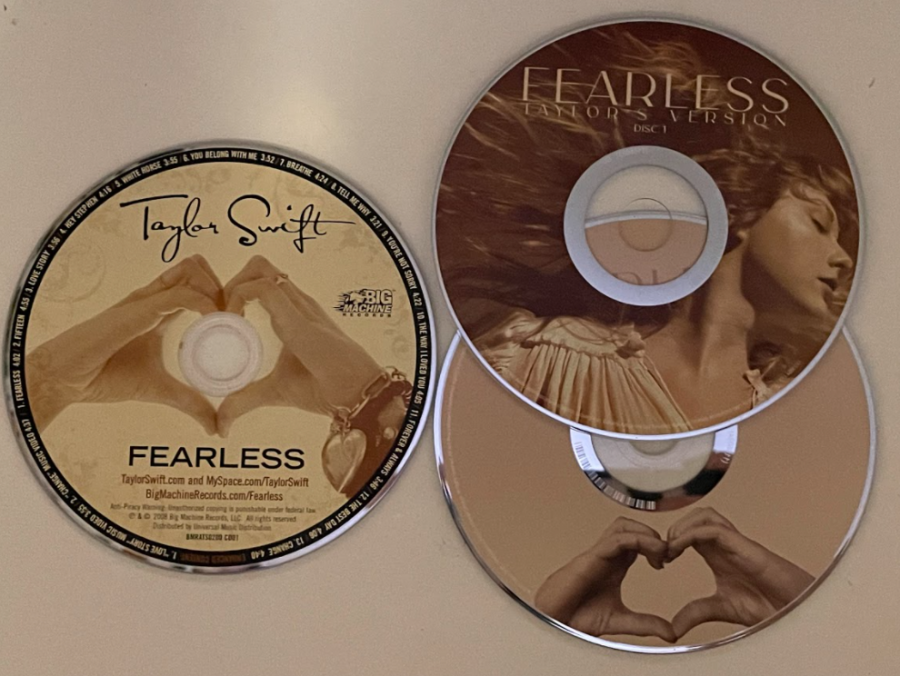Comparing Fearless (2008) and Fearless (Taylor’s Version)(2021)
A comparison of Taylor Swift’s CD’s, which version is better?
Oct 28, 2021
On April 9, 2021 Taylor Swift released her highly anticipated re-recorded version of her sophomore album Fearless, this time titled Fearless (Taylor’s Version). The original version was released on November 11, 2008 when Swift was just 18 years old. Swift began the process of re-recording her first six albums in November 2020.
WHY IS SWIFT RE-RECORDING HER OLD ALBUMS?
Under Republic Records, Swift has released four albums: Lover (2019), folklore (2020), evermore (2020), and now Fearless (Taylor’s Version). Previously, she had been signed to Big Machine Records, where she released six albums under the management of Scooter Braun: Taylor Swift (2006), Fearless (2008), Speak Now (2010), RED (2012), 1989 (2014), and reputation (2017). In 2019, Braun obtained the rights to those albums, and in October 2020 sold the masters, or recordings, of those albums produced with Big Machine Records to Shamrock Holdings.
Swift, who has been passionate about the right of artists to own their work, remained the holder of the compositions, or the actual sheet music, for the albums. She decided to re-record the first six albums so she would be able to control how it would be displayed in media and hold complete copyright over a newer version.
“Artists should own their own work for so many reasons, but the most screamingly obvious one is that the artist is the only one who really *knows* that body of work,” Swift said in an Instagram post in February 2021.
Swift also decided to surprise her fans with six new songs that were never released on the original versions of the albums.
“I’ve decided I want you to have the whole story, see the entire vivid picture, and let you into the entire dreamscape that is my fearless album,” Swift said in that same Instagram post. “That’s why I’ve chosen to include six never before released songs on my version of this album. Written when I was between the ages of 16 and 18, these were the ones it killed me to leave behind.”
HOW DO THESE ALBUMS COMPARE TO EACH OTHER?
As a very avid Taylor Swift fan, I was so excited to hear that Taylor was re-releasing the album that made me a fan back in 2008. To get to hear my favorites, like “Hey Stephen” and “The Best Day” as well as classics like “You Belong With Me” for the first time once again was truly an insane experience.
Upon hearing the redone album for the first time, I immediately noticed how much clearer and mature Swift’s voice sounded. The audio was so much crisper and there was vast improvement in her voice strength in the last thirteen years of the original album being out – her voice has clearly matured since she was 18. However, there definitely was not as much emotion in Taylor’s new version as there was in the original version, as she recorded the songs up to fifteen years after they’d been written and the passion was not as clear as it was in the original.
With that being said, “Mr. Perfectly Fine,” one of the six new tracks released from her figurative vault of unreleased songs, was one of the most passionate songs I’ve ever heard. It may have been invigorating for Swift to finally release a song she had been dying to release since she wrote it, which could explain the extreme emotion in the song.
Fearless (Taylor’s Version) is also a significantly better album than that of its original because of the addition of the vault tracks. Swift added six new songs: “You All Over Me,”, “Mr. Perfectly Fine,, “We Were Happy, “That’s When”, “Don’t You”, and “Bye Bye Baby”. Because these tracks were all never before heard, it added so much more to the album. “You All Over Me”, “That’s When”, and “Mr. Perfectly Fine” were, in my opinion, the better half of the vault tracks that helped pull together this album for a third time (its original release, the platinum version release, and now the re-recorded version). They captured the youthfulness and passion of Fearless expressed in teenage love and angst. My opinion of Fearless being the quintessential teenage album is only reinforced with the addition of those three new tracks.
The album also featured other artists, all of which were or were supposed to be featured on the original. Colbie Caillet was featured on “Breathe” once again, Keith Urban on “That’s When,” and Marren Morris on “You All Over Me.” The addition of featured artists once again was so cool to see, and it made me happy to see this was not completely a solo project and many of the original components of the album would still be there.
All in all, the re-recording of the album is just as nostalgic as the original and although it got some time to get used to because of the new strength of her voice and some slight instrumental differences, I’ve listened to it so many times from “Fearless” to “Bye Bye Baby” that the original version sounds odd to listen to. For an artist to re-record an album and have their listeners prefer the new version over the old version is a talent not many artists possess. Swift has built up such a massive fanbase and discography over the years and her fans have been dying to hear the new versions of each song since she dove head first, fearless into the re-recording area in November 2020. Add that to the merch she has sold to commemorate the new albums, like clothing and CDs, and Swift has helped encourage her fans to push her versions of the songs to be more popular than the original.






